If you have fresh fruits in your house, you are also likely to have some fruit flies. But what if you don’t have fruits at home and some pesky pests are flying around? Well, they are small black-flying bugs, not fruit flies. For sure, there are other reasons why they are there. But first, you should know what they are.
So, what are the small black flying bugs that are inside your house but are not fruit flies? Depending on the size and appearance, they could be houseflies, fungus gnats, phorid flies, drain flies, or flying termites. All of these flying bugs can cause severe infestation indoors despite having different characteristics.
Most tiny black flying bugs are winged insects that go through complete metamorphosis, which means they undergo four stages in their life cycle.
Meanwhile, flying termites undergo incomplete metamorphosis. This lengthy article will teach you a lot about flying bugs in houses and how to get rid of them.
Top 5 Small Black Flying Bugs in House, Not Fruit Flies
Flying bugs can enter your house without a warning. These uninvited guests may look like fruit flies, but they are not.
Unfortunately, most of them will invade your homes and can transmit infectious diseases to humans. Here are the five most common types of small black flying bugs in houses:
1. Houseflies
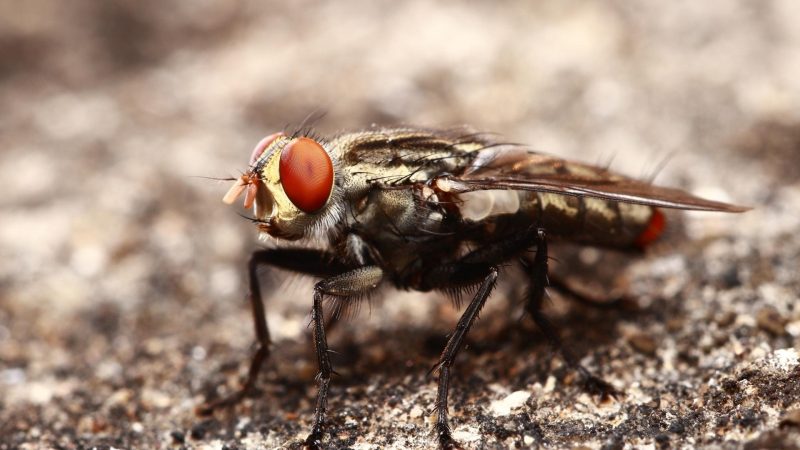
What Do Houseflies Look Like?
Scientifically called Musca domestica, houseflies are usually black or gray and have a single pair of wings. They also have slightly hairy bodies, four dark stripes at the back of their thorax, and very complex compound red eyes.
Adult house flies are about 1/8-1/4 of an inch (3.175-6.35 mm) and buzz while they are flying.
The housefly larvae go through three instar development stages before becoming full-grown maggots. The earliest instar larvae are white, cylindrical, and about 3-9 mm long.
On the other hand, adult maggots are about 7-12 mm long. These legless maggots can already feed on waste and manure.
Where Do Houseflies Live?
Generally speaking, houseflies live in any area where they can lay eggs. But most of the time, they prefer unsanitized areas such as garbage, manure, decaying grass clippings, and rotten vegetables and fruits.
These dirty pests are mostly outdoors but may also enter a household to breed and search for food.
What Attracts Houseflies Inside Your Home?
Houseflies are very attracted to houses with white surfaces, ultraviolet light, warm areas, and foul-smelling substances such as overflowing dumpsters, dirty drains, and rotten food products.
These little black flying bugs in your house entered through cracks around windows and doors, especially during daylight hours.
What Diseases Do Houseflies Carry?
Houseflies don’t bite humans, but they are suspected to be carrying more than 100 diseases. This includes anthrax, cholera, diarrhea, dysentery, leprosy, poliomyelitis, tuberculosis, tularemia, typhoid fever, and yaws.
These serious illnesses can be transmitted to humans through contaminated food, air, and water.
What Are the Signs of a Housefly Infestation?
The presence of multiple houseflies buzzing around inside your house is the most common sign of a housefly infestation.
You may also spot some legless maggots crawling out of their breeding material as they enter the pupal stage. You may also see young and small houseflies emerging from their pupal cases.
How to Get Rid of Houseflies at Home Naturally?
Getting rid of houseflies indoors is a huge challenge, especially if there’s already an infestation. Using insecticide is not recommended due to health reasons.
Aside from that, the effect is also temporary, and you have to spray them from time to time. Therefore, here are some natural ways to get rid of houseflies at home.
- Sticky fly traps such as can catch houseflies effectively and kill them.
- Cheap fly swatters are also time-tested but it’s better if you use Garsum Fly Swatter with Long Wire Handle .
- Essential oils such as cinnamon, sunflower, tea tree, vetiver, and lavender repel houseflies.
- Traps with attractive bait, including sugar, wine, meat, or a mixture of soap and apple cider vinegar.
Note, however, that the effectiveness of these methods mainly depends on how you apply them, as well as the severity of the problem.
Related: House Fly Control: How To Get Rid of House Flies?
2. Fungus Gnats
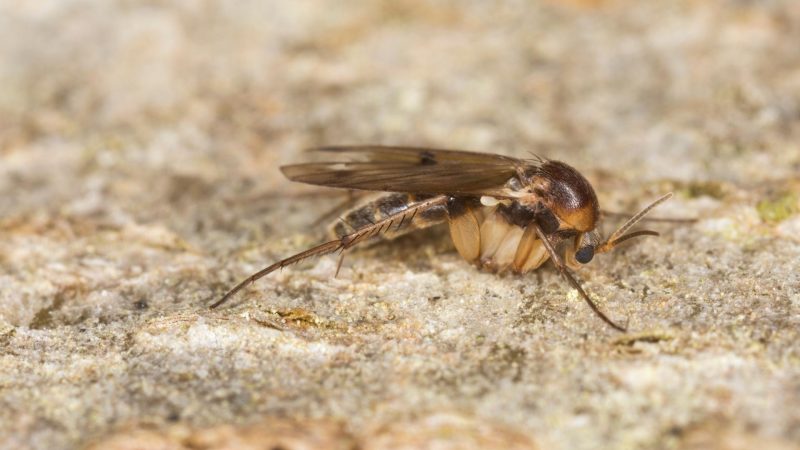
What Do Fungus Gnats Look Like?
Fungus gnats are small-bodied flies that look like mosquitoes but are smaller. Adult fungus gnats are only about 1/16 to 1/8 inches (1.5 to 3 mm) long and have a unique ‘Y’ pattern on their forewings.
These tiny black flying bugs also have dark wings, long slender legs, and bead-like antennae that are longer than their head.
On the other hand, fungus gnat larvae look like worms and are about 1/4 inch (6.35 mm) long. They have a shiny, black head and a translucent, elongated body.
Unlike their adult versions that don’t eat and only consume liquid, these legless maggots feed on algae, compost, fungi, mulch, and plant roots.
Where Do Fungus Gnats Live?
Fungus gnats typically live in greenhouses where plants are abundant, but they can also live indoors with potted plants.
These plant pests love staying in chronic sources of moisture and mulched areas, where their larvae can rapidly become pupae. Unlike houseflies, fungus gnats are weak fliers, so they habitually stay in one place only.
What Attracts Fungus Gnats Inside Your Home?
Fungus gnats are very attracted to wet mulch piles and moist-growing media of houseplants, both indoors and outdoors.
These tiny flying bugs in houses are also attracted to light, which is why you can also see them in windows and light fixtures. They also cannot resist the smell of sweet scents of flowers and fruits.
What Diseases Do Fungus Gnats Carry?
Fortunately, adult fungus gnats don’t carry infectious diseases, and they don’t bite humans or damage plants. But still, their larvae stages can damage roots, stunt plant growth, and kill healthy plants.
They are capable of transmitting plant diseases such as Fusarium spp, Verticillium wilt, Pythium spp, and black root rot.
What Are the Signs of a Fungus Gnat Infestation?
The common signs of a fungus gnat infestation include significant root damage, infested soil from a manufacturer, sudden wilting of plants, bright yellow leaves, and a high population of fungus gnats on the plants.
The problem with these symptoms is that they can also be due to a lack of water or soil issues.
How to Get Rid of Fungus Gnats at Home Naturally?
As mentioned above, fungus gnats are plant pests and are not dangerous to humans.
So far, the best way to prevent them from entering your house is not to have indoor plants. But if there is already a fungus gnat infestation in your garden, here are some effective ways to get rid of them naturally:
1. Yellow Sticky Trap
Fungus gnats are attracted to yellow, which is why Gideal 20-Pack Dual-Sided Yellow Sticky Traps or similar products work well against them.
Simply place these traps on the soil surface near your plants, and you will later see dead fungus gnats trapped on them. This may only be a temporary solution, though.
2. Diatomaceous earth (DE)
Food-grade diatomaceous earth (DE) kills adults and larvae of fungus gnats by absorbing oils and waxes on their outer cuticle, which serves as their protection.
After about a week, the fungus gnats will be dehydrated and die. But to make it effective, the soil should be dry before applying a layer of DE on top of it.
3. Nematodes
Nematodes are microscopic roundworms that can be used as an organic control against fungus gnats, both adults and larvae.
Live nematodes such as Nema Globe 4003224 Fungus Gnat Nematodes are readily available online.
However, make sure that you buy the live ones and store them in cold places but not frozen.
Related: How to Get Rid of Gnats in House? | 9 Effective Ways
3. Phorid Flies
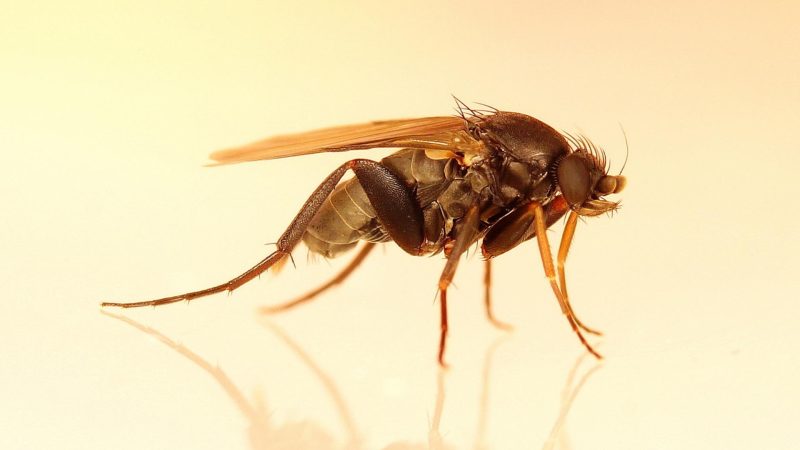
What Do Phorid Flies Look Like?
Phorid flies are a huge family of small flies with more than 3,500 species around the world. Also called scuttle flies, these annoying pests look like fruit flies but fly in an erratic manner instead of in a straight line.
Depending on the species, they can be yellowish-brown, dark-brown, or black and are about 1/8 inch (3.2 mm.) long.
Generally speaking, phorid flies have a short, narrowed abdomen, an enlarged femur on their third pair of legs, and an arched thorax which gives them a hump-backed appearance.
Their larvae are cylindrical, cream in color, and about 3 mm long. Meanwhile, their pupae are elongated and about 4 mm long.
Where Do Phorid Flies Live?
Phorid flies usually live in wastes, broken garbage disposals, leaky or broken septic lines, wet potted plant soil, flower vases, and feces.
These fast runners can also be present in homes, buildings, and hospitals with unsanitized kitchens, sinks, toilets, and storage areas with rotten fruits or spoiled food.
What Attracts Phorid Flies Inside Your Home?
Phorid flies are very attracted to liquid wastes associated with decay, rotting dead animals such as rats, the smell of dirty dishes, and old food, among others.
These nuisance pests enter houses by taking advantage of open doors and windows, as well as wall cracks and crevices and other possible tiny openings.
What Diseases Do Phorid Flies Carry?
Just like most fly species, phorid flies also don’t bite humans. But because they feed on wounds, feces, garbage, and decaying carcasses, these little black flying bugs in houses can cause serious health issues for people.
They can potentially carry infectious diseases such as gastroenteritis and conjunctivitis.
What Are the Signs of a Phorid Fly Infestation?
The most apparent sign of a phorid fly infestation is the presence of their adults buzzing around. In some cases, you may not see them at once if they are in underground soil contaminated by leaky septic lines.
If the infestation is severe, deep and expensive excavation is required to remove the contaminated soil.
How to Get Rid of Phorid Flies at Home Naturally?
Some techniques for getting rid of houseflies can also be applied to phorid flies, especially traps and essential oils.
But since phorid flies are more abundant in septic lines, liquid wastes, and decaying matter, they are easier to find. The key here is proper sanitation, especially in hidden areas where water is present.
4. Drain Flies
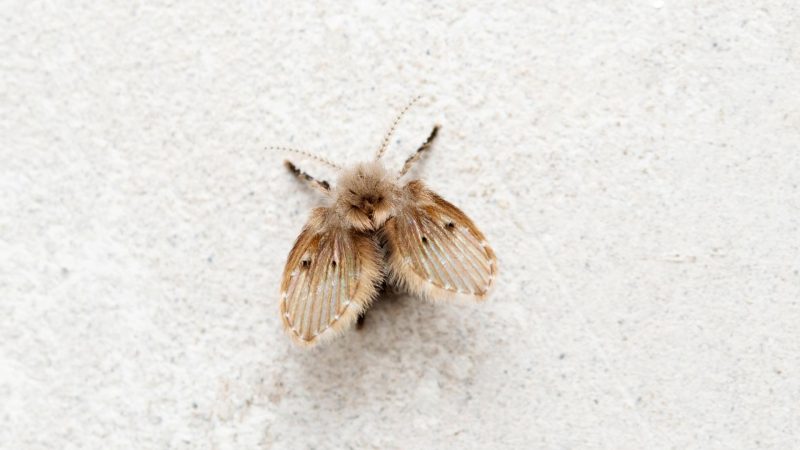
What Do Drain Flies Look Like?
Also known as moth flies, drain flies look like moths because their dark wings are also covered with scales or fine hairs.
They are about 1/8 inch long and have small dark bodies and parallel wings from the base to the tip of their wings. When resting on a surface, their wings are held over their back like a roof on their bodies.
Meanwhile, moth fly larvae are usually brown but sometimes look banded because of being light brown in the middle and darker on the ends.
They undergo three larval stages and are around 1/4 inch long in their final stage. These legless larvae have a distinct head and a siphon on one end that is usually overlooked.
Where Do Drain Flies Live?
Drain flies usually live in wet manure, sewer or shower drains, underground septic tank field lines, or in any area where water accumulates consistently.
These small black flying bugs in houses may live along the water surface of toilet bowls, kitchen sinks, water tanks, and drain pans under refrigerators.
What Attracts Drain Flies Inside Your Home?
Indoors, drain flies are very attracted to pipes, drainage areas, standing water, and wet animal manure.
Drain fly larvae feed on algae, bacteria, and fungi, while adults feed on sewage or any decomposing organic matter. Adults are weak fliers, so they only make short hopping flights, particularly when disturbed.
What Diseases Do Drain Flies Carry?
Drain flies don’t bite humans and are not known to be carrying serious diseases. But then, they can potentially carry pathogens that can trigger bronchial asthma in weak people.
Once larvae land on food and are accidentally swallowed, they can cause a minor parasitic infestation. In short, they are not life-threatening.
What Are the Signs of a Drain Fly Infestation?
The presence of adult drain flies in huge numbers is a very clear sign of a drain fly infestation, especially in a stagnant pool of water.
If a certain drain is being infested, you may also see them resting on walls near the drain. Nevertheless, the infestation can be temporary once the water is already running or moving.
How to Get Rid of Drain Flies at Home Naturally?
As their name suggests, the favorite locations of drain flies are the drains. So, to get rid of them, you should eliminate their breeding sites.
Once you have confirmed that these tiny black flying bugs are present in your sink drain, you can remove them without using harmful chemicals. Here are some methods you can try:
- Pour hot water down the drain. But then, this solution is not permanent and should be done repeatedly.
- Cleaning pipes and traps with a stiff brush is a better solution.
- Alternatively, use antibacterial drain products such as Bio-Clean Ultimate Drain Cleaning Kit but repeat applications are also required.
Related: Drain Flies Control: How To Get Rid of Drain Flies?
5. Flying Termites
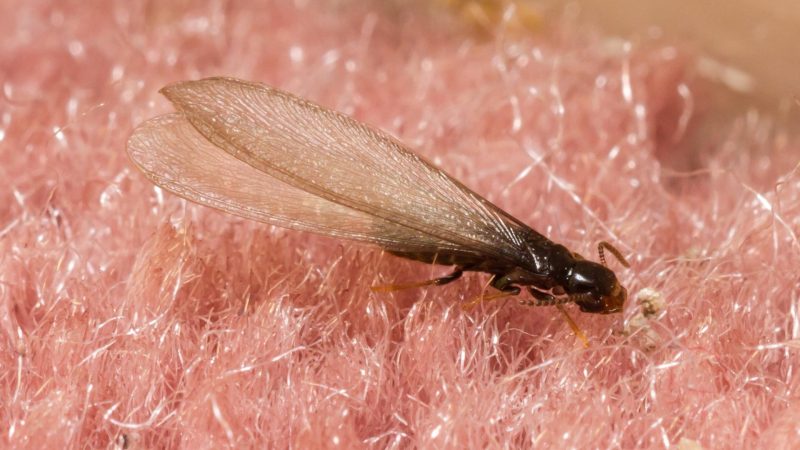
What Do Flying Termites Look Like?
Flying termites are usually mistaken for carpenter ants because of their similar physical appearance. However, flying termites are mostly black, while carpenter ants vary from orange-brown to black.
They also have a uniformly thickened waist, a straight antenna, and two pairs of transparent wings of the same size.
Also called winged termites or swarmers, flying termites are part of a termite colony, and their main purpose is to find another area where they can establish a new colony.
This is also why they are referred to as reproductive termites. But unlike wingless worker termites, they don’t damage wooden structures or homes.
Where Do Flying Termites Live?
Flying termites live in landscape timbers, tree stumps, or any area where there is wood. They are usually produced in large quantities, especially in the spring or fall.
Once these tiny black flying bugs can fly, they leave the colony to find another place to stay. In short, they don’t have a permanent home or territory.
What Attracts Flying Termites Inside Your Home?
Flying termites are very attractive to almost all sources of artificial light, such as street lights, outdoor motion lights, and fluorescent lights indoors.
Although these alates love to swarm around the lights, they also enter homes in search of food, water, and shelter. Then, they shed their wings on the floor and look for a mate.
What Diseases Do Flying Termites Carry?
Flying termites don’t carry diseases, and they don’t bite humans. Nonetheless, their counterpart workers may bite humans but are extremely rare. Termite bites are not dangerous since their mouth is very small.
In general, termites don’t pose health risks to humans, but their workers can cause severe damage to houses.
What Are the Signs of a Flying Termite Infestation?
Flying termites don’t infest homes and buildings but their huge presence is a sign that there is a colony of termites nearby.
Termite workers and soldiers are not usually seen because they are in their underground nests or connecting tubes. In short, having only a few flying termites may or may not lead to termite infestation.
How to Get Rid of Flying Termites at Home Naturally?
If you are to get rid of flying termites only, you can use a vacuum cleaner or any liquid spray. In most cases, these winged termites will eventually die once they touch the lights.
But so far, the best way to drive them away is to turn off the lights. On the other hand, eliminating termites may need help from professionals.
Related: Do Termites Fly? | All You Need to Know!
List of Sources
Merchant, M. (2016). Indoor Flies and Their Control. Texas A&M AgriLife Extension.
Gerry, A. C. (2015). Flies. University of California Agriculture & Natural Resources.
Cransaw, W. S., Cloyd, R. A. (2009). Fungus Gnats as Houseplant and Indoor Pests. Colorado State University Extension.
Theuret, D., Gerry, A. (2014). Moth or Drain Flies. University of California Agriculture & Natural Resources.
Peairs, F. B. (2014). Termites. Colorado State University Extension.
- How to Get Rid of Copperheads | Practical Guide - August 27, 2023
- How to Get Rid of Corn Snakes | What Makes Them Aggressive? - August 27, 2023
- How to Get Rid of Alligators | Safety Measures and Removal Methods - July 16, 2023

